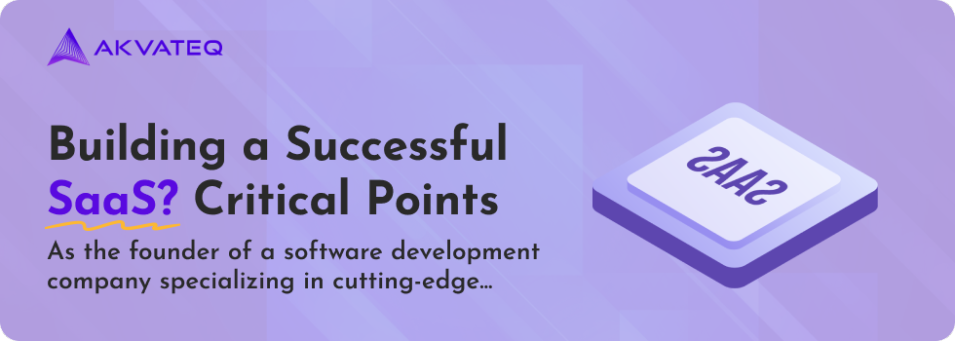As the founder of a software development company specializing in cutting-edge SaaS products, I’ve learned some hard-won lessons about evaluating ideas and prioritizing when building a successful SaaS. With the SaaS model continuing to disrupt nearly every industry, I constantly meet hopeful founders exploring new web or mobile app concepts. Yet despite the vast market opportunity, the sobering reality is that 9 out of 10 of these ideas will inevitably fail.
Why such grim odds? In my experience, it typically comes down to problematic assumptions made in the early conceptual stages before extensive time and resources get invested in bringing a minimum viable product (MVP) to market.
So before you quit your day job or hire a dev shop to build the next unicorn, here are 4 must-validate rules of thumb:
Validate Market Demand Before Building a Successful SaaS
It’s tempting to think no competition means a wide-open, untapped market opportunity. But in most cases, similar ideas have already been attempted and failed to gain traction. Just because a solution sounds clever in your eyes doesn’t mean target customers need or want it.
The most common mistake I see is founders falling in love with an app concept before doing validation. They assume that because nothing exists to scratch their itch, other users must have the same need. Or they rely solely on surveys where people are happy to tell you what features sound nice to have.
But the best validation is when strangers get excited enough about your idea to engage, provide feedback, or maybe even pre-commit to a paid pilot before you write a single line of code. I can’t stress enough the importance of mockups and landing pages to test demand before over-investing in a slick MVP nobody ultimately uses.
Fail Fast Through Rapid Iteration
Once validating genuine market interest, the next recommendation may sound counterintuitive…resist the temptation to build every possible feature on day one! Even with demonstrated customer enthusiasm, the biggest risk is overengineering an initial product release that tries to be everything to everyone.
The irony is that endless internal debates trying to define an exhaustive master blueprint often delay getting ANY working software in users’ hands. And the later you initiate that feedback loop of rapid iteration, the harder it is to course correct.
That’s why the lean startup pioneers advocated minimally viable products (MVPs) as quickly launching the barest essentials core that early adopters find value in. Set aside fancy bells and whistles for V2.0. If traction stalls at the MVP stage, it signals difficulty in achieving product-market fit.
get in touch to discuss your project
Evaluate Competitive Landscape Risks
Most founders adequately assess alternatives CURRENTLY solving a customer’s problem but underestimate indirect substitution effects. Buyers may tolerate existing flawed options rather than buy an unproven solution.
A common justification for entering a crowded market is claiming better technology, features, or UX. But displacing incumbents with financial resources, existing integrations & mindshare is extremely difficult without differentiation.
Before committing to any concept, objectively map the competitive landscape and consider barriers to entry. If the runway is limited, prioritize ideas better positioned as the “underdog” rather than directly confronting entrenched market leaders without an unfair advantage.
Model Realistic Pricing Assumptions
Finally, a surprising number of founders neglect to rigorously pressure test basic operating economics before locking into development. The uncomfortable truth is that much time and money gets wasted building products that have no underlying financial viability at scale.
Early on, lay out hypothetical revenue and cost assumptions at maturity. Estimate willingness to pay based on the intensity of customer problems and alternatives. Then right-size expenses are needed to deliver, service, and enhance that SaaS solution across thousands of accounts.
If the customer lifetime value at implied pricing can’t sufficiently cover CAC plus overhead, the mature unit economics won’t work. Refine pricing models or avoid spaces with structural margin limitations.
Get started on creating your own SaaS product with Akvateq!
No doubt about it, the SaaS industry is booming right now. Businesses, including small startups, are realizing the advantages of making SaaS products. It’s especially great for small and medium-sized companies. Jumping into the SaaS world today could lead to big opportunities and rewards later on.
Sure, getting into the SaaS market can be a bit tricky. You need to really understand how things work. But don’t worry, our SaaS product development team can help you.
The Akvateq team is here to help you out. Akvateq is the best SaaS development company in town. We’re experts in making SaaS products and we want to share our knowledge with you. We can guide you through the whole process, whether you’re starting from scratch or changing your current services into SaaS. Just give us your contact info, and we’ll reach out to you. Let’s chat!
Please have a look on our successfully developed SaaS products. Leadcarrot.io Consolidata.ai and Knockio.com


















